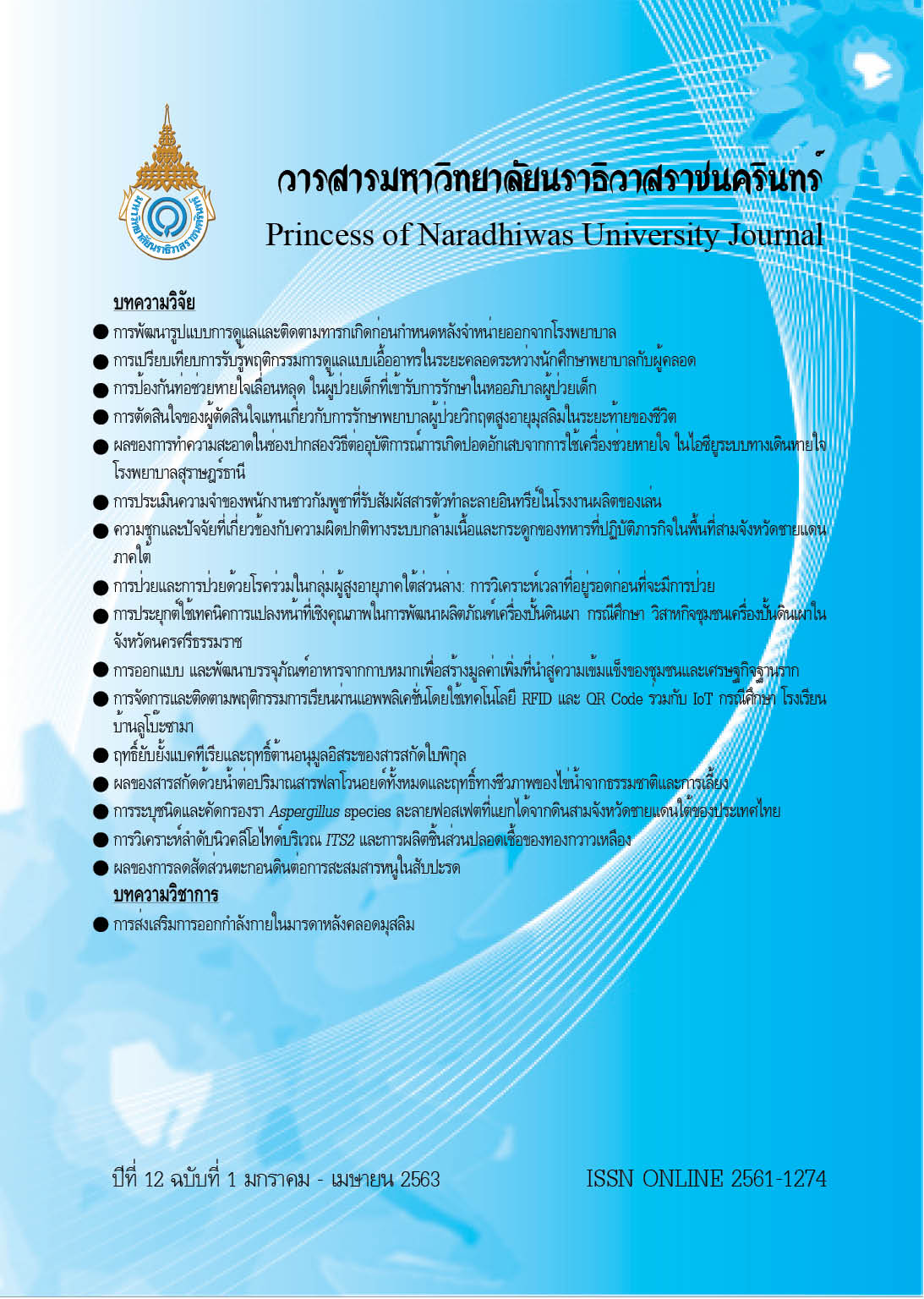Memory Assessment of the Organic Solvents Exposed among Cambodian Workers in a Toy Manufacturing Factory
Keywords:
Organic Solvents, Memory Assessment, Cambodian WorkersAbstract
The objectives of this study were to assess the memory of Cambodian workers who were exposed to organic solvents from color painting in a toy manufacturing factory, and compare the memory between an exposed and a control group. The sample size of each group was 103 workers. Data were collected using interview form and the Psychology Experiment Building Language (PEBL) computer program for digit span forward and backward memory scores for memory impairment evaluation. Data were analyzed using independent samples t-test.
The results showed that both Cambodian worker groups had similar characteristics. The analysis of memory scores from the digit span forward and backward test between exposed and control group revealed that the exposed group had less memory scores of both digit span backward tests. The digit span forward and backward memory scores of exposed group were significantly different from control group at less than 0.01. The t-test score equal to -2.842 (0.756, - 0.137) and -3.221 (-0.736, - 0.177), respectively. The data from this research can be used as a guideline for employee health care in order to prevent memory defects from work.
References
Anger, W. K. (2003). Neurobehavioural tests and systems to assess neurotoxic exposures in the workplace and community. Occupational & Environmental Medicine, 60, 531-538.
Dick, F. D. (2006). Solvent neurotoxicity. Occupational & Environmental Medicine, 63(3), 221- 226.
Dissayavanish, P. (1999). Psychological and Psychology assessment. In Sirsurapanont, M. & Dissayavanish, J. (Ed.),
Psychology Medical Textbook of Chiangmai University (pp. 65-97). Chiangmai: Sangsilp press. (in Thai)
European Commission. (2009). Information notices on occupational diseases: a guide to diagnosis. Retrieved from http://bookshop.europa.eu/uri?target=EUB:NOTICE:KE8009534:EN:HTML
Kaukiainen, A., Hyvärinen, H. K., Akila, R., & Sainio, M. (2009). Symptoms of chronic solvent encephalopathy: Euroquest questionnaire study. NeuroToxicology, 30(6), 1187-1194.
Kongkamol, C. (2006). Comparative study of cognitive functions between workers exposed and workers not exposed to mixed organic solvents in Samutprakarn province. Master’s Thesis, Occupational Medicine, Faculty of Medicine, Chulalongkorn University. (in Thai)
Laan, G. v. d., & Sainio, M. (2012). Chronic Solvent induced Encephalopathy: A step forward. NeuroToxicology,
(4), 897-901.
Meyer-Baron, M., Blaszkewicz, M., Henke, H., Knapp, G., Muttray, A., Scha¨per, M., et al., (2008). The impact of solvent mixtures on neurobehavioral performance-Conclusions from epidemiological data. NeuroToxicology, 29, 349-360
Mueller, S. T., & Piper, B. J. (2014). The Psychology Experiment Building Language (PEBL) and PEBL Test Battery. Journal Neurosci Methods, 222, 250–259.
Mueller, S. T. (2018). The PEBL manual programming and usage guide for The Psychology Experiment Building Language PEBL Version 2.0. Retrieved from http://pebl.sourceforge.net
Thetkathuek, A., Jaidee, W., Saowakhontha, S., & Ekburanawat, W. (2015). Neuropsychological symptoms among workers exposed to Toluene and Xylene in two paint manufacturing factories in eastern Thailand. Advances in Preventive Medicine, 2015, 1-10.
United States Environmental Protection Agency. (2016). Toluene. Retrieved from http://www.epa.gov/sites/ production/files/2016-09/documents/toluene.pdf
Valen, E. v., Thriel, C. v., Akila, R., Nilson, L. N., Bast-Pettersen, R., Sainio, M., et al., (2012). Chronic solvent-induced encephalopathy: European consensus of neuropsychological characteristics, assessment, and guidelines for diagnostics. NeuroToxicology, 33(4), 710-726.
World Health Organization. (1996). Biological monitoring of chemical exposure in the workplace guidelines. Geneva: n.p
Yu, I. T., Lee, N. L., Zhang, X. H., Chen, W. Q., Lam, Y. T., & Wong, T. W. (2004). Occupational exposure to mixtures of organic solvents increases the risk of neurological symptoms among printing workers in Hong Kong. Journal of Occupational and Environmental Medicine, 46, 323-330.




